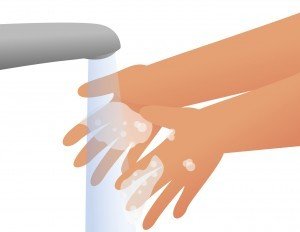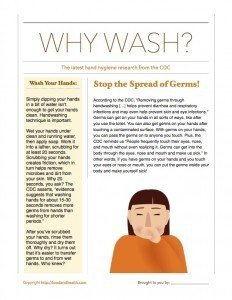The CDC and the Science Behind Handwashing
 Handwashing can help stop the spread of germs. By stopping the spread of germs, handwashing can in turn help people avoid getting sick. According to the Centers for Disease Control and Prevention (CDC), "Removing germs through handwashing [...] helps prevent flu, viruses, respiratory infections, foodborne illnesses, and may even help prevent skin and eye infections."You see, germs can get on your hands in all sorts of ways. As you might expect, a variety of germs can get on your hands after you use the toilet (or after you help someone else use the toilet or change a diaper). But that's not the only instance. You can also get germs on your hands after handling raw meat or touching a contaminated surface after someone has coughed on it. With germs on your hands, you too can contaminate surfaces and pass the germs on to anyone else you touch. Plus, the CDC reminds us "People frequently touch their eyes, nose, and mouth without even realizing it. Germs can get into the body through the eyes, nose, and mouth and make us sick." In other words, if you have germs on your hands and you touch your eyes or nose or mouth, you can put the germs inside your body and make yourself sick! That's why it's important to wash your hands after instances when you may have gotten germs on them.
Handwashing can help stop the spread of germs. By stopping the spread of germs, handwashing can in turn help people avoid getting sick. According to the Centers for Disease Control and Prevention (CDC), "Removing germs through handwashing [...] helps prevent flu, viruses, respiratory infections, foodborne illnesses, and may even help prevent skin and eye infections."You see, germs can get on your hands in all sorts of ways. As you might expect, a variety of germs can get on your hands after you use the toilet (or after you help someone else use the toilet or change a diaper). But that's not the only instance. You can also get germs on your hands after handling raw meat or touching a contaminated surface after someone has coughed on it. With germs on your hands, you too can contaminate surfaces and pass the germs on to anyone else you touch. Plus, the CDC reminds us "People frequently touch their eyes, nose, and mouth without even realizing it. Germs can get into the body through the eyes, nose, and mouth and make us sick." In other words, if you have germs on your hands and you touch your eyes or nose or mouth, you can put the germs inside your body and make yourself sick! That's why it's important to wash your hands after instances when you may have gotten germs on them. It's also vital to wash your hands before, during, and after handling any food. The CDC points out, "Germs from unwashed hands can get into foods and drinks while people prepare or consume them. Germs can multiply in some types of foods or drinks, under certain conditions, and make people sick."
It's also vital to wash your hands before, during, and after handling any food. The CDC points out, "Germs from unwashed hands can get into foods and drinks while people prepare or consume them. Germs can multiply in some types of foods or drinks, under certain conditions, and make people sick."
Of course, simply running your hands in a bit of water isn't enough to get your hands clean.
Proper handwashing technique is important too.
- Wet your hands under clean, running waterApply soap.
- Work it into a lather, scrubbing for at least 20 seconds. But why scrub, and why do it for your whole hands? "Lathering and scrubbing hands creates friction, which helps lift dirt, grease, and microbes from skin. Microbes are present on all surfaces of the hand, often in particularly high concentration under the nails, so the entire hand should be scrubbed" (source).
- Now let's move on to another common question -- why wash your hands for at least 20 seconds? According to the CDC, "evidence suggests that washing hands for about 15-30 seconds removes more germs from hands than washing for shorter periods."
- After you've scrubbed your hands, rinse them thoroughly.
- Dry them off with a clean towel. Why bother drying them? The CDC has the answer for that too, stating, "Germs can be transferred more easily to and from wet hands; therefore, hands should be dried after washing."
- Repeat this process any time you use the bathroom, cough, sneeze, touch public or dirty surfaces, see dirty on your hands, or handle raw food items.
- Use alcohol based hand sanitizer only if soap and water is not an option because it is not as effective as a soap and water process. Make sure the sanitizer is 60% alcohol.
And there you have it. The hows and whys behind handwashing.Perhaps you're wondering why we spent so much time discussing proper hand hygiene this week. With the concern about the coronavirus outbreak, people are scrambling to buy hand soap and all sorts of supplies and they want to learn more. You see, the more people know about handwashing, the more likely they are to stay healthy. Information we found from -- you guessed it! -- the CDC reveals, "Handwashing education in the community reduces the number of people who get sick with diarrhea by 31%, reduces diarrheal illness in people with weakened immune systems by 58%, and reduces respiratory illnesses, like colds, in the general population by 16-21%.”That's pretty significant, and it prompted us to put a few more resources together to help you teach people about proper hand hygiene. I hope you've enjoyed these posts!And here's a free PDF handout with the highlights of all this research... [shopify embed_type="collection" shop="nutrition-education-store.myshopify.com" product_handle="flu-and-virus-posters"]
[shopify embed_type="collection" shop="nutrition-education-store.myshopify.com" product_handle="flu-and-virus-posters"]
